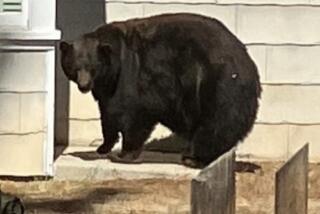Brake for Moose, Maine Doctor Advises
- Share via
LEBANON, N.H. — Dr. John Sutton brakes for moose. But he’s fascinated by people who don’t.
The surgeon and chief of trauma at Dartmouth-Hitchcock Medical Center has carved a niche for himself by analyzing the injuries people receive when their cars and trucks collide with a moose.
Sutton’s colleagues call him Dr. Moose. But it’s no laughing matter for victims of moose collisions.
It took almost a month for doctors to remove all the glass from Audrey Carr’s eyes after her car hit a moose last spring in rural Dorchester. Her husband, who was driving, was cut on the arms and chest. The steering wheel was crushed and the windshield shattered.
“The moose just about took the roof off the car,” said Carr, who was knocked unconscious. “It caused $9,000 worth of damage to the car.”
In fact, Sutton found that 23 people were hospitalized at Maine’s Dartmouth-Hitchcock Medical Center and Eastern Maine Medical Center over 4 1/2 years for injuries suffered in moose-vehicle accidents and that two of them died of head injuries. Seventy percent of those who were not killed suffered head or facial injuries, and 26% had severe spine injuries.
Sutton said most moose-vehicle accidents demolish the car and kill the moose. Moose have no natural predators in northern New England and don’t run from a car’s headlights. They can also grow nearly six feet high and weigh more than 1,200 pounds.
Among other things, Sutton found that cars often hit the moose under the belly, lifting it off its feet and onto the passenger cab, which is crushed by the impact. His advice: When a collision with a moose looks inevitable, aim for the hindquarters.
In New Hampshire, where yellow “Brake for Moose” signs dot highways, Sutton estimated that 200 to 250 moose-vehicle collisions occur every year. He put the number at 650 or more in Maine. Vermont doesn’t track the number of moose-auto collisions, but he estimated more than 80 moose died in such accidents last year.
In rural northern New England, “the likelihood of hospitals here to be taking care of someone who has hit a moose is greater than someone who’s been shot or stabbed,” said Sutton, who blames the increase in part on greater human traffic in rural areas.
“Everyone seems to have a moose story,” said Sutton, who himself nearly hit a moose 20 years ago. “A moose ran out of the woods,” he recalled. “We swerved, and the moose ran alongside us for about 20 yards, so it was a near-miss.”
Sutton hopes his work will help emergency rooms deal better with the injuries. He also would like to see cars better designed to withstand moose collisions. And he urges drivers not to speed on rural roads at dusk or at night, when the creatures are almost impossible to see.
“Their coats don’t reflect anything,” recalled Louise Jordan of Northfield, who almost hit two moose four years ago. “I thought, ‘Why are there trees in the road?’ I didn’t realize they were moose.”
The time of year also affects the chances of hitting a moose. They’re more likely to wander onto roads in the spring and summer, when they are foraging, and during the early fall, when they’re rutting.
Overall, though, the chances of hitting a moose are slim, Sutton said. He has seen only about four hospital admissions this year.
“It’s really more of an issue for moose,” he said. “They almost always die in the accidents.”
More to Read
Sign up for Essential California
The most important California stories and recommendations in your inbox every morning.
You may occasionally receive promotional content from the Los Angeles Times.













